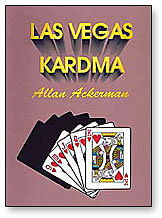Las Vegas Kardma by Allan Ackerman
Reviewed by Jamy Ian Swiss (originally published in Genii October, 1994)

Allan Ackerman's name will not be new to any serious cardician. Over the years he has
produced three small volumes that have found enormous favor, if not wide distribution,
with the cognoscenti of carddom. Magic Mafia Effects, The Esoterist, and especially,
Here's My Card, have influenced a large number of cardicians over the past nearly
twenty years. Fortunately, much of that material will be gathered and re-released some
time in the future. After an absence of some eight years, during which Mr. Ackerman
essentially left the conjuring community due to a number of unfortunate thefts of credit
for his material, he returned a few years ago with several interesting lectures. With the
release of this volume, Mr. Ackerman will doubtless receive even wider acceptance for
his legitimate and interesting contributions to the field.
Mr. Ackerman's material has something for everyone. There are tricks requiring
substantial technical ability, interesting and useful sleights of mixed technical demands,
and some unusually good material requiring no sleight of hand at all. In the self-working
department, for example, Mr. Ackerman's oil and water routine is effective, though
devoid of sleights. A Self-Working Quick Coincidence is an excellent four-way
coincidence effect that appeared in Here's My Card, but has been simplified so that
anyone can do it.
In the sleights department, Mr. Ackerman has, in the past, contributed a number of
excellent variants on the spread cull controls, and here provides several new and equally
useful developments, including related palming techniques and controls, along with
several other technical items. Among the more technically demanding performance
material, one especially notable routine is Ackerman's Opener. This is a strong series of
cleverly-routined effects, beginning with popular contemporary classics like Elmsley's
Brainweave and Vernon's Triumph, leading into a memorized deck routine and
climaxing with a remarkable culling demonstration. As with several other of Mr.
Ackerman's routines, this latter segment requires the use of a memorized stack, a
condition which may set some students running in the other direction (or at least to the
next page). But the result in this case is a routine guaranteed to bowl an audience over.
Another trick worthy of special notice is Impromptu Paul Fox, a deceptive routine in
which the mage mentally divines the selections of four spectators. There is also a section
of previously-unreleased Marlo routines, including a handling and presentation of Persi
Diaconis' Les Cartes Diaconis.
This is the first book produced by A1 Media, until now noted for their quality
instructional videos. As a first effort, this book scores well on content, but less so for
production. The writing is simple and direct, but Mr. Ackerman could have greatly
benefitted from more diligent and competent editing and proofreading. At times, the
descriptions become murky to a point dangerously close to incomprehensibility. Indeed, the author's intentions are occasionally only rescued by the illustrations—except that the
illustrator's name, Hannah Ammar, is nowhere to be found! The design is
unsophisticated; we have boxes within boxes within pages that are boxed within
outlines, indecipherable running footers, and here is yet another book filled with
underlined type, a device which most designers abandoned with their electromechanical
typewriters. What ever happened to italic fonts? A1 should be permitted some leeway in
this, their first foray into book publishing, and I trust that their design skills will
improve in the future.
Mr. Ackerman makes serious attempts at responsible crediting, but there are some
misses. A devoted Marlophile, Mr. Ackerman never misses an opportunity to credit his
mentor—as when he gives credit to Marlo for first pointing out that Dai Vernon's
Triumph shuffle retains the order of the deck, a rather obvious routining point, implicit
in a sentence in the original Stars of Magic description. In the description of Mr.
Ackerman's small packet all backs routine (first published in Don England's T.K.O.'s by
John Mendoza—although the latter name is nowhere to be found in this volume), the
author mentions a trick "done with gimmicked cards" by John Thompson. Yet the
original trick was performed with unprepared cards, and was erroneously credited to
Mr. Thompson in Epilogue by Karl Fulves. This was in fact a routine of Harry Riser's,
which incorporated ideas by Milt Kort and Al Saal in applying Marlo's Quick 3-Way
sequence to this plot. In the only coin routine in the book, a worthy Reverse Matrix
which uses no extra coins and in which all four coins first assemble together, Mr.
Ackerman pleads ignorance of the parentage of a loading technique which, I believe,
belongs to David Arthur (ref. Coinmagic by Richard Kaufman).
Nevertheless, there is much of value here for the card aficionado, novice or advanced.
There is an odd appendix which may be of use to the beginner, describing, for example,
the Elmsley Count, the Up the Ladder false cut, the Faro Shuffle and the Zarrow Shuffle,
while at the same time ignoring a number of lesser-known sleights and techniques
which Mr. Ackerman makes reference to in his text. There is little in the way of
presentational information, which is probably an appropriate reflection of Mr.
Ackerman's strengths and limitations. He is, after all, a professional mathematician, not
a performer. But Mr. Ackerman is highly regarded by many, and much of this material
demonstrates why.
